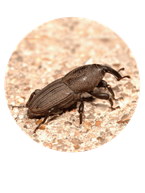The Problem
Black cutworm (BCW) (Agrostis ipsilon) infests cool-season greens and tees throughout the entire country, but damage is rarely observed in higher mowed turf. Black cutworm larvae typically hide in aerification holes chewing grass blades around the hole. This results in slow aerification recovery which is often the first noticeable symptoms of BCW infestations. Black cutworm cannot survive subfreezing soil temperatures so they overwinter only in the transition zone and farther south. In the far southern U.S., there may be five or six generations of BCW with fewer generations farther north. Adults of BCW migrate north on strong southern winds, flying hundreds of miles with spring storm fronts. Adult moths usually appear in late- April in Ohio, larval damage usually appears about one month later, and damage may be seen for the rest of the summer with up to two or three generations of BCW. In more northern states, BCW adults will arrive up to a month later where usually only two generations occur.
What To Look For
Adults of BCW are gray to dull brown hairy moths with a wingspan 1 to 1.75 in. There is a black distinctive dagger-shaped marking in the center of each wing about 0.25 in. from the tip of the forewing. Female BCW lay up to 2000 eggs on grass and weeds. Newly hatched larvae are about 0.125 in. long and can reach 1.75 in. long and 0.2 in. in diameter when full grown after six or seven instars. Larvae are gray to black with the underside a slightly lighter gray. Larvae usually have black dots along both sides of their body with a pale stripe down the center of the back. Feeding may continue for up to 40 days before larvae pupate and cease feeding. Adults can be attracted to black light or pheromone traps but, are most often detected during mowing. Larvae are usually first suspected in aerification holes that are slow to recover, and can be detected with a flush of lemon-scented dish soap at 0.5 oz./gal. water. During the feeding, damage often shows up as circular spots of dead grass or depressed spots that resemble ball marks on golf greens. Infested areas also attract foraging birds that disrupt the turf surface by pulling up tufts of grass.
The Solution
Cultural control of BCW is best achieved through the removal of clippings from greens and tees, which research suggests should remove 75-97% of BCW eggs. However, 90% of the BCW eggs can survive mowing. Larvae can crawl up to 30 feet/night, so clipping disposal should be 100 yards or more from any greens or tees. Early morning mowing (before 5:30 AM) one day per week is also reported to kill most cutworm larvae before they can return to their burrows. Though larvae often use aerification holes as burrows, it is important to note that aerification does not favor or encourage BCW infestation.
Season-long control can be achieved with targeted applications of a systemic insecticide like Tetrino®. Preventative applications can be scheduled 2-3 weeks after adults are first seen. In some cases, multiple applications may be needed typically 2-3 months apart because of the multiple generations observed throughout the season. Synthetic pyrethroids and other contact insecticides such as Dylox® can be used as curative applications. These should be timed when birdfeeding is first observed or with slow-to-heal aerification holes, followed by soap flush to confirm BCW. Sprayable applications are preferred for uniform coverage.
Additional resources
| Solution sheet -Black cutworm (BCW) |








